Advances based on mobile technology are poised to revolutionize spectrometers.
As spectrometers shrink in cost, size and power consumption, their applications grow. Proof can be found in agriculture, medicine and the arts, to name just three different and distinct areas.
Now, innovations derived from mobile technology promise to render the current
crop of spectrometers obsolete. For instance, the days when instruments record and measure spectra for analysis at a single spot could be numbered.
“All spectrometers will be imaging spectrometers, and the nonimaging ones will be archaic,” said Mike Morris, president of spectroscopy product distributor SpectrEcology of Jasper, Ga.
A founder of spectrometer maker Ocean Optics, Morris has seen such disruption happen before. Previously, he noted, the application of low-cost bar-code line-scan technology allowed desktop instruments to be transformed into spectrometers that were handheld
or smaller.
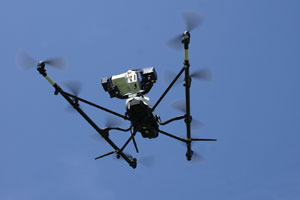
Instruments like this miniature spectrometer mounted on a drone could make agriculture more efficient by assessing crop health. Photo courtesy of Andreas Burkart, Institute of Bio- and Geosciences.
Spectroscopy in agriculture
For an illustration of what spectrometer miniaturization enables, consider agriculture. At the moment, the best way to gauge crop health is old-fashioned: a farmer walking around a field and looking at plants. But that’s not good enough.
“There are too many people for the space we have to grow food, so the farmer has to be more efficient,” said Andreas Burkart, a graduate student at the Institute of Bio- and Geosciences at Germany’s Jülich Research Center.
Studies have shown that fertilizer, insecticide and fungicide are applied at up to double the optimum rate. That is inefficient in multiple ways, from waste on the farm to pollution in runoff. It would be better to interrogate the plants and use this data to tailor water, fertilizer and insecticide for a given crop and situation.
That is the goal of Burkart’s research. By looking at the spectral signature of plants, researchers hope to assess crop health remotely. Farmers can then precisely apply only what the plants need, thereby improving agricultural efficiency.
Previous efforts have attempted to do this with a ground-based, handheld instrument that measured reflectance spectra. To account for changes in sunlight, this data is compared to that of a reference. Burkart is part of a group looking at taking the same measurements via small spectrometers mounted on airborne drones, an approach that offers some significant potential benefits.
“It’s quicker,” Burkart said. “The field of view of the spectrometer can cover a larger area, so you integrate or average over the whole area.”
But this also places demands on the spectrometer: It must be light, inexpensive and low power, yet still provide enough accuracy and spectral information.
Burkart was the lead author of a study published in the January 2014 issue of IEEE Sensors Journal. In the paper, the researchers showed that a microspectrometer and associated electronics that came in a scant 216 g – less than half a pound – could perform as well as, and in some ways better than, a ground-based instrument. The two approaches produced equivalent reflectance spectra, and the airborne method yielded measurements with a sixfold smaller standard deviation.
Further research is needed, as the spectral signal may vary from crop to crop. Right now, a farmer can still beat instruments when it comes to judging plant health. But Burkart is hopeful that further work will change that. He also would like to see hyperspectral imagers that capture both spectral and spatial information in a single snapshot.
Spectroscopy in dentistry
A second area in which spectroscopy advances are enabling new applications
is dentistry. For cavity filling, silvery amalgams are out and polymers are in. These materials must be cured using light in the violet-to-blue range. The energy needed for different polymers runs from 3 to 48 J/cm2 or, equivalently, as much as 48 W per square centimeter applied for a second. However, curing lights in a dental office vary a great deal.
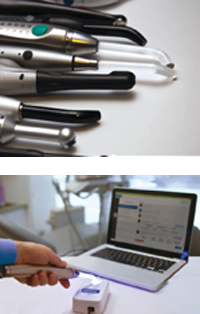
A wide variety of lights and polymers are used
by dentists in curing cavity fillings. Curing-light intensities can be
checked using a microspectrometer with proprietary instrumentation and
software. Photos courtesy of BlueLight Analytics.
“We’ve tested lights [with] as little as 50 mW/cm2 output at the light tip across the range from 380 to 540, which is the range used in dentistry, to as high as 7000 mW/cm2. So you’re seeing a big range,” said Colin Deacon, president and CEO of BlueLight Analytics of Halifax, Nova Scotia.
Besides the difference in the light output, other factors are the location of the tooth and the depth of the cavity, Deacon added. Polymer down in a deep hole in a molar in the back of the mouth will see curing-light intensity that is significantly different from that of a polymer in a shallow cavity in a tooth at the front of the mouth.
If the light intensity is too low, the polymer may not cure completely throughout. If the intensity is too high, pulp cells in the teeth can be killed through excess heat.
Given its name, it’s not surprising that BlueLight Analytics offers measurement and training tools to help dentists avoid such problems. The company can do so because it has access to small, inexpensive spectrometers, combining these with proprietary light collectors and sophisticated software.
For dentists, successfully filling cavities is critical. This service represents a significant part of their income, and yet the cost of even an inexpensive spectrometer is several times that of a curing light. For that reason, BlueLight Analytics sells testing services, and that places additional constraints on equipment. It has to be robust enough to take repeated trips to different dental offices.
Spectrometer advances would be welcome. At the moment, however, instrument performance is not a barrier to this application, according to Deacon.
Spectroscopy in art
A third and final example of a domain where spectroscopy advances are having an impact is that of art conservation and authentication. Spectroscopy has long been used to interrogate art objects. Characteristic spectral fingerprints, for instance, may indicate that a particular pigment was used in a painting, thereby determining whether the picture is the work of a master or a forger.
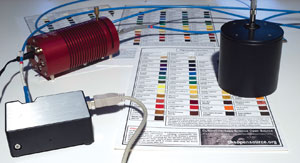
This miniaturized reflectance spectroscopy system is used to measure swatches of historical pigments. The system consists of (from left to right) a halogen lamp, a spectrometer and an integrating sphere probe. Photo courtesy of Antonino Cosentino.
Larger museums and academic institutions have used reflectance and Raman spectroscopy for decades for just such work. Smaller museums and private collectors, however, have faced a problem. They are unable to afford or justify the cost of these instruments. Consequently, one option would be to ship off a work to a well-heeled facility, where it would sit until testing was complete. Then it would be shipped back.
Antonino Cosentino gained years of experience in the examination of artwork while in academia. He left that position because he felt that the miniaturization of spectrometers and other instruments offered a new choice. “I wanted to fill the gap between innovative and affordable technologies and the art conservation sector,” Cosentino said.
He now works mostly on art authentication for private collectors, museums and conservators through the Cultural Heritage Science Open Source of Aci Sant’Antonio, Italy. Cosentino carries his instruments to the artwork, traveling with the equipment on low-cost flights. He currently has a miniaturized reflectance spectroscopy system and plans to add Raman spectroscopy capability soon. The idea is to put all devices into a suitcase, from which the instruments can be unpacked on-site.
Cosentino got into this line of business in part because testing showed that an inexpensive, portable and miniature spectrometer fared well when compared with a larger and much more costly benchtop system. He has found many times that a less expensive tool, such as a commercial camera equipped with the right filters, can get good enough results.
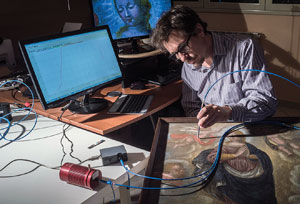
Examining a painting with a miniaturized spectrometer at the Cultural Heritage Science Open Source Center in Italy. Photo courtesy of Antonino Cosentino.
Ideally, he’d like to have one instrument that can do many tasks, such as a reflectance spectrometer that can also perform Raman spectroscopy. In any case, what he’s doing has attracted considerable interest, he noted, because many institutions and individuals cannot afford the more expensive systems.
In the end, it is what can be done with the instruments – not their cost – that’s important. “The final goal is to have better preservation of our cultural heritage,” Cosentino said.
Future advances
For a sense of where spectrometers and their possible applications are headed in the future, it helps to look at the past. The current crop of mini- and microspectrometers had their origin in other photonics-dependent applications.
“The miniature spectrometer was essentially piggybacked off the developments in telecoms and fax machines or scanners. That’s where the chip originally came from,” said David Creasey, vice president of sales and marketing at Ocean Optics of Dunedin, Fla.
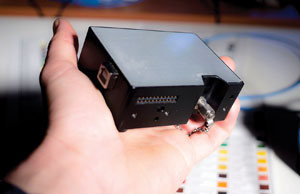
Thanks to miniaturization, a reflectance spectrometer fits into one hand. Photo courtesy of Antonino Cosentino.
Today, a great deal of research and development is going on in mobile and handheld devices. One result is a boom in wireless communication capabilities, and another is the advent of low-power electronics suitable for battery operation.
On the photonics front, the mobile focus has meant the availability of very low cost and low power yet high-pixel-count image sensors. Predictions are that having all of those pixels will allow the development of imaging spectrometers – devices that provide spectral information by location without the need for repeated measurements.
That technology can be combined with recently available ultraviolet LEDs to produce fluorescence-related or hyperspectral imaging. One possibility would be to use this capability to detect hydrocarbon spills or algae blooms in water, said Morris of Spectrecology. Other hybrid instruments could combine different measurements into one device, resulting in spectroscopy advances that could lead to new and potentially very wide ranging applications.
“All matter can be interrogated with electromagnetic radiation: light,” Morris pointed out. “So, in principle, if we have enough tools in our spectroscopy tool kit, we could measure anything.”